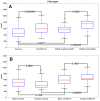Clotting Factors in COVID-19: Epidemiological Association and Prognostic Values in Different Clinical Presentations in an Italian Cohort
- PMID: 32392741
- PMCID: PMC7290348
- DOI: 10.3390/jcm9051371
Clotting Factors in COVID-19: Epidemiological Association and Prognostic Values in Different Clinical Presentations in an Italian Cohort
Abstract
Introduction: A novel highly pathogenic human coronavirus able to induce severe acute respiratory syndrome (SARS) has been recently recognized as the cause of the coronavirus disease 2019 (COVID-19) outbreak, which has spread rapidly from China to other countries. Little is known about laboratory prognostic markers in COVID-19 patients. The aim of our study was to describe the basic clotting parameters in COVID-19 patients and their prognostic role in different clinical forms of the disease.
Material and methods: We enrolled 67 COVID-19 patients admitted to the Emergency Department. A cohort of 67 age- and sex-matched non-COVID-19 patients with acute respiratory illness was used as a control group. For all patients, platelet count (PLT), prothrombin time (PT), activated thromboplastin time (aPTT), C-reactive protein (PCR), fibrinogen, and D-dimer were determined. The COVID-19 population was divided in two groups according to the presence or absence of SARS. The clotting factors values were compared between the groups.
Results: At admission, the COVID-19 patients showed statistically significant increased levels of fibrinogen (601.5 (480-747) vs. 455 (352.5-588.5) mg/dL; p = 0.0000064), and a higher percentage of patients had fibrinogen levels >400 mg/dL (86% vs.58%; p = 0.0054) compared to the control group. The levels of fibrinogen were higher in COVID-19 patients with SARS compared to those without SARS (747 (600.0-834.0) vs. 567 (472.5-644.50); p = 0.0003).
Conclusion: Fibrinogen seems to increase early in COVID-19 patients and may be used as a risk stratification marker for the early detection of a subgroup of COVID-19 patient at increased risk to develop SARS, who might benefit from a different and thorough clinical surveillance and treatment.
Keywords: COVID-19; SARS-CoV2; alteration of hemostasis; disseminated intravascular coagulation; fibrinogen; prothrombin time.
Conflict of interest statement
The authors declare no conflict of interest.
Figures




References
-
- Liu J., Zheng X., Tong Q., Li W., Wang B., Sutter K., Trilling M., Lu M., Dittmer U., Yang D. Overlapping and discrete aspects of the pathology and pathogenesis of the emerging human pathogenic coronaviruses SARS-CoV, MERS-CoV, and 2019-nCoV. J. Med. Virol. 2020;92:491–494. doi: 10.1002/jmv.25709. - DOI - PMC - PubMed
-
- Zhou F., Yu T., Du R., Fan G., Liu Y., Liu Z., Xiang J., Wang Y., Song B., Gu X., et al. Clinical course and risk factors for mortality of adult inpatients with COVID-19 in Wuhan, China: A retrospective cohort study. Lancet. 2020;395:1054–1062. doi: 10.1016/S0140-6736(20)30566-3. - DOI - PMC - PubMed
LinkOut - more resources
Full Text Sources
Research Materials
Miscellaneous

